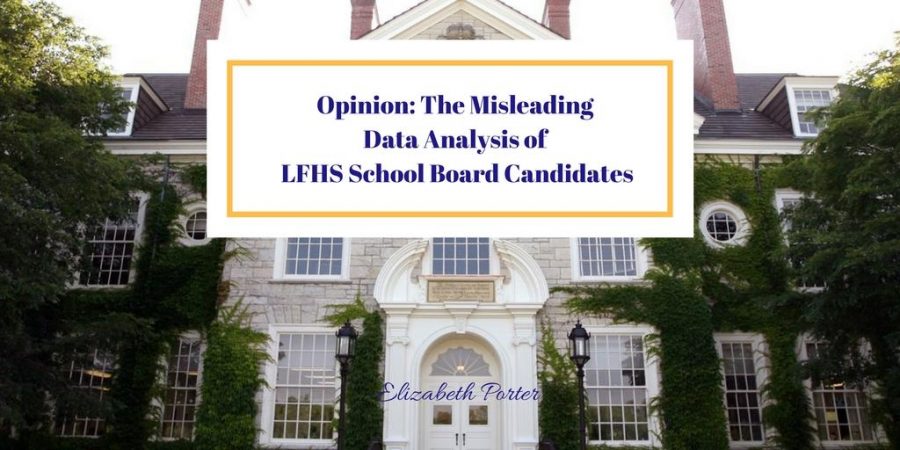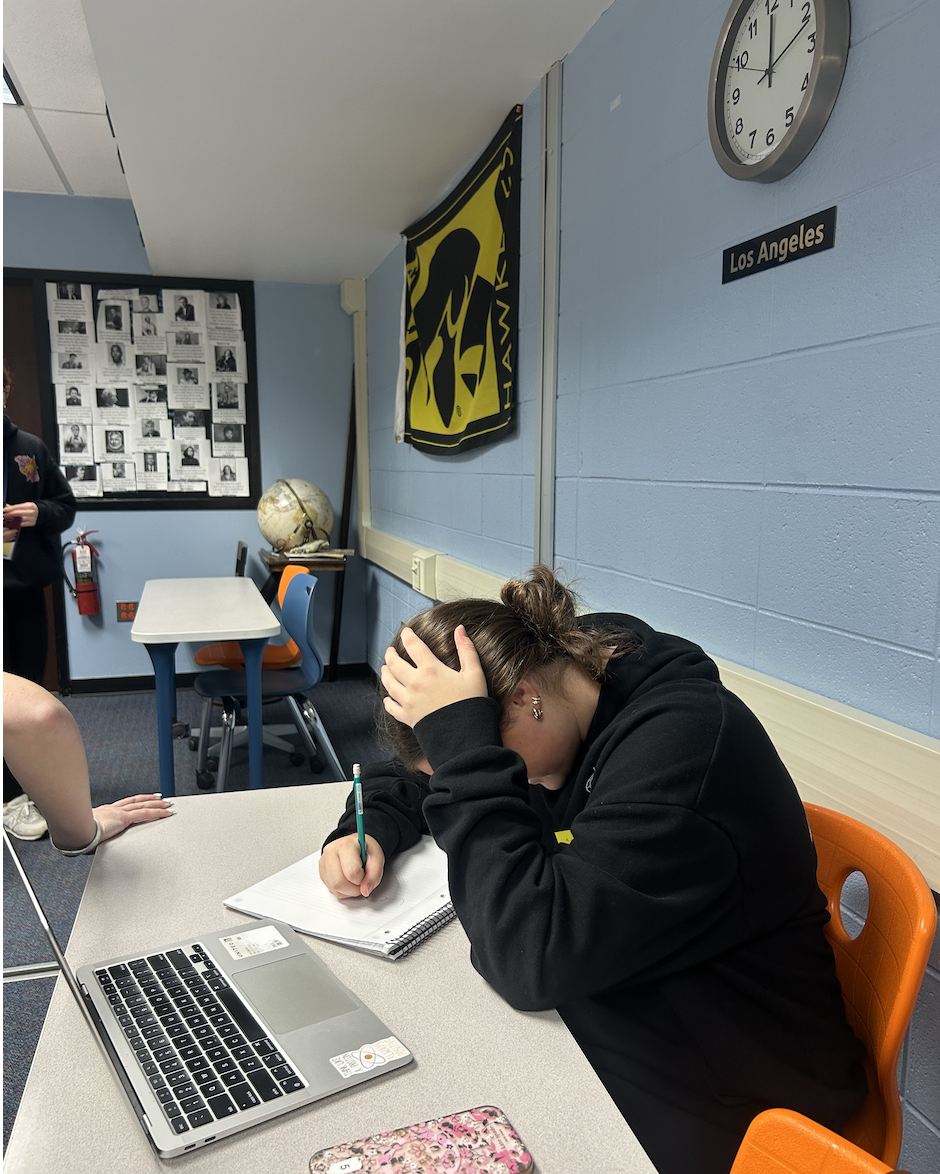The following article is an op-ed by junior staff writer Elizabeth Porter. The opinions and viewpoints expressed within are solely that of the author and may not fully reflect the ideas of The Forest Scout as a whole or any other individual student on the staff of the newspaper.
When it comes time for any election, from presidential to school board, it is imperative that citizens are informed. Candidates will shove information down your throat. You are guaranteed emails, TV commercials, pamphlets in the mail, Facebook posts, news articles, and canvassers at your door. But among all the chaos, we sometimes lose the most vital part of it all: the truth. Voters deserve to be presented with the truth, and allowed the opportunity to form their own opinions.
Lately there’s been a great deal of discussion about whether it’s true that Lake Forest High School educates students effectively. There are those who believe it is doing well and others who claim it has lost sight of its goals and aspirations. Both sides point to data that they say supports their position. But, the same set of statistics can be used to prove almost any point, if you have a little creativity. As students, we have our own perspectives about our school, and we’re taught to think critically about statistics we are provided. Here is my view on the truth about Lake Forest High School.
Drug and Alcohol Use
Drug and alcohol use is an important issue facing every community. For example, a group running for the District 115 School Board, self-labeled as the Final Four, asserts on their campaign website that drug and alcohol use has risen disastrously at LFHS in recent years. The heading regarding this issue reads, “Alcohol and Drug Abuse at All Time Highs at LFHS,” and then recites that “[t]he Illinois Youth Survey presentation at the January 2017 LFHS Board meeting showed a disastrous rise in teen drinking at LFHS: 41% of 10th graders admitted alcohol use in the past 30 days and 22% of 10th graders admitted binging on alcohol in the past 30 days. This is a significant rise from 2010. The news is even worse for 12th graders surveyed: 60% admitted using alcohol in the past 30 days and 40% admitted binge drinking.” Wow. That sounds like a cause for concern, right?
But take a look at their charts; they tell a different story.


Charts from Final Four website, LFHS4.com. Issues tab.
The green line on the top represents teen drinking. Does that line appear to be rising disastrously? As you can readily see, the top green line in the above two charts fluctuates every year, but has actually declined since 2006, both for 10th and 12th graders.
What is the reason for dramatically different interpretations of the same data? In this case, the difference is the starting point. In the written statement accompanying the charts, the Final Four choose to measure 2016 in relation to 2010. And, since 2010 is one of the lowest levels in the past 10 years, it’s not surprising substance use shows an increase when measured against that particular year. However, their graph starts at 2006, apparently a year in which LFHS students’ drinking among the senior class was very high. So when we view all of the information on the graph, we can plainly see that from 2006 to 2016 drinking and drug use have actually declined.
Thus, by strategically picking their starting year for their statement, they have turned a trend that has declined into one that has increased. To understand trends and an enduring problem like teenage drug and alcohol use, it makes sense to use all the data available. Unless there is something unrepresentative or irrelevant about the years 2006 to 2010, throwing them out is discarding useful information and experience. And, in any case, the headline of this section–“Alcohol and Drug Abuse at All Time Highs at LFHS”–is not true.
Though one might ask the question: Why use this data for judging the quality of education at Lake Forest High School? The survey question was not whether teens were drinking at school. Instead, the question is really about what is occurring in Lake Forest and Lake Bluff basements. School officials and teachers can do some things to discourage drinking–offer education on the dangers of drinking or penalize athletes caught drinking–which our school does, in fact, do. But unless students are drinking at school or school events, how can the school be held responsible for the personal choices of students and their parents? Fortunately, teen drinking has declined significantly since 2006 and we should all be proud. When I look at this data, I don’t see an indictment of our schools as much as an affirmation of our parents and teens.
AP Program
One indicator of the priorities of the current school administration is the amount of resources dedicated to the Advanced Placement program. On this issue, the Final Four notes that the current AP program has sacrificed “Quality” for “Quantity,” and then displays a diagram with a picture indicating an 11% decline in “Top score of 5 on the AP exam” from 2011 to 2016, the only statistic that might be said to measure the “Quality” of the AP program.
As to quantity, the Final Four is right and in agreement with the Lake Forest District 115 School Board, who presented the data below regarding the dramatic growth of the program. In just the past two years, LFHS has expanded its AP offerings, from 22 classes to 30. According to the annual School Profiles, last year 586 individual students took AP exams, compared with only 413 in 2014. In only two years, 173 more students decided to challenge themselves and go through the heavy workload required in AP classes. As a result, last year, students passed 1,168 AP tests, compared to 813 in 2014. That’s a difference of 355 more tests passed, which means a lot more college-level credit for a lot more LFHS students. Based on this information, it seems as though the AP program, and LFHS academics in general, is thriving.

Chart from Lake Forest High School District 115 Assessment Report 2015-2016
Well, what about the purported decline in scores of 5? If you think critically about the data, there must be more students passing AP tests with 5s in the expanded program. Though the percentage of 5s may have declined, because so many more tests are being taken, the number of AP exams receiving 5s has actually increased. The 2015-16 School Profile shows that 39% of AP test takers last year scored a 5, which means 488 tests passed with a score of 5. 38% of tests received 5s in 2011-2012, but it was a lot fewer in number because the program was much smaller. Unfortunately, I could not locate the School Profile for the comparison year 2010-11 which the Final Four cite, but it’s unlikely the data is much different and the same principle should apply. That is– even if the percentage of 5s was higher in the past, the actual number was not.
What seems obvious to me from the data is that the quantity and quality of the AP program has improved in the past couple years. More students are taking and passing more AP tests, and scoring as well as they ever have. In recognition of that, the school was recently awarded a position on the AP District Honor Roll by the College Board. It is awarded to schools that have increased access to AP courses while maintaining or increasing the number of students who score a 3 or higher. Only 433 schools nationally have accomplished this special distinction.
Standardized Test Scores
Perhaps the gold standard in rating high schools is performance on the dreaded college-admission tests, the ACT and SAT. Here, this same group asserts that LFHS’ SAT scores are in “Sad Decline.”
But the first question is, why use the SAT data? Before this school year, nearly every junior at LFHS has taken the ACT each year. Meanwhile, according to school administrators, only 33 students reported taking the SAT last year. Unlike the ACT, the SAT was always taken outside of school by only a handful of students, most of whom were applying to top-tier colleges; therefore, it’s a small sample and not representative of the school as a whole.
Thus, ACT scores are the most useful scores for analyzing how well LFHS is preparing all of its students for college. Fortunately, using that data we have a consistent set of nearly all students over a period of many years. How have we done on the ACT? Our ACT scores have been consistently excellent. In 2012, LFHS’s average composite ACT score was 26.9, excluding the scores of students given extended time. In 2016, LFHS’s average of this same population of students was 27.1. This data clearly shows stability at a high level. In fact our collective composite score puts us in the 83rd to 87th percentile across the nation, which basically means that the average kid at LFHS is in the top 85% in the nation.

Chart from Lake Forest High School District 115 Assessment Report 2015-2016
So the bottom line is that the most-representative data as well as the average ACT scores over the years, tell a great story: LFHS students continue to be well prepared for college relative to other students across the country.
To conclude my report card for LFHS, I believe the data strongly supports the following story: In the past few years, the AP program has thrived–more classes, more students, more passing scores, and more affordable college credit earned. Drug and alcohol use has gone down. Our average composite ACT score is at an all-time high, and our scores suggest that the 95% of us who go to college are well-prepared.
In light of the data and my experiences, I have formed my own, individual, understanding of the truth–Lake Forest High School is doing a great job.
I’m the first to acknowledge my view aligns closely with the campaign of the Right Track candidates. It may seem odd that I have not discussed their claims and statistics. The reason is that I’ve looked at them and they seem to agree with the data the administrators provide. Regardless of this, I am not offering a blanket endorsement. I do not want anyone who reads this article to form their opinions solely on mine, even though everything I have included is the truth to the best of my knowledge. If you believe the Final Four are telling you the truth, vote for them. If you believe the Right Track candidates are telling you the truth, vote for them. But no matter what, take a few moments to educate yourself. Read what both sides are saying, look up statistics, speak to your neighbors, make an informed decision, and vote. Democracy does not work without informed citizens, and unfortunately we are not always guaranteed the truth from candidates for office, so we must seek it for ourselves. That is what I have done, and that is what I hope you chose to do.




















Ryan • Mar 10, 2017 at 6:02 pm
Good article Elizabeth, you should submit to JWC Daily for more exposure!
Frank • Mar 7, 2017 at 10:36 pm
This is truly impressive. Great work! I hope you pursue a career in statistics and analytics – the field desperately needs more womyn!
Janet White, PsyD, MEd • Mar 6, 2017 at 7:35 pm
Thank you for demonstrating the excellent education LFHS students receive today; your comprehensive analysis of the data which provides a very complete understanding of the platform of each candidate.
Anon • Mar 6, 2017 at 1:02 pm
This is a pretty one sided commentary on the candidates for the school board. What is left unsaid is the amount of tax dollars that go towards educating each student. LFHS spends more per student than let’s say- Stevenson and we fall short consistently in test schools.
This is a very thoughtful look and I agree with many points but this is a critical look at ONE group of candidates, not at all of them.
Anonymous2 • Mar 6, 2017 at 4:48 pm
I have no idea whether this is true in fact, but Stevenson is considerably larger than LFHS, and perhaps there are economies of scale that result in lower costs per pupil. I have no dog in this fight, but am simply pointing out a logical possibility. It would take some effort to determine if my surmise is correct or not. I’m not a student there, and I have no student in LFHS. I must say, that this young author has done a very competent job of providing context and her point of view on this limited question.
Ryan • Mar 10, 2017 at 6:19 pm
You cannot effectively compare LFHS to Stevenson or New Trier even. LFHS is half the size of those schools. LFHS only spends 23k per student. And the students do not fall behind in test scores either. If you read the data, test scores have been trending upwards over the last few years and LFHS is quite competitive with the other north shore schools. Don’t believe the “fake stats” that are being disseminated.